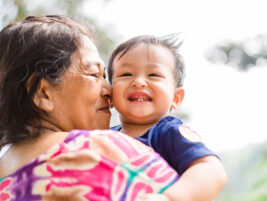
In parallel with the preparation of this issue of the Signal, including the review and revision process, a research article appeared in the July issue of the Journal of the American Academy of Child and Adolescent Psychiatry (Feldman & Vengrober, 2011) on the high prevalence (37.8% , n=148) of PTSD (Post Traumatic Stress Disorder) among infants and toddlers (1.5 -5 years) exposed daily to war-related trauma. The major resilience factors that differentiated the ExposedPTSD group from the Exposed-non PTSD group, were maternal PTSD, depression and anxiety levels and support networks (Note: Unfortunately, fathers were not included in this study, though, in our clinical experience, they always have a direct and indirect impact, via the quality of co-parenting, on the infant’s adjustment to adverse life situations). An additional, interesting finding was that children diagnosed as having PTSD exhibited high levels of avoidant behavior towards their mothers during the evocation of traumatic memories by the mother. Maternal proximity to the traumatic event and the mother’s PTSD symptoms correlated with the child’s avoidance symptoms (gaze aversion, emotional withdrawal, increased preoccupation with objects, and physical distancing from the mother). Furthermore, maternal depression and PTSD predicted the child’s avoidant behavior.
This study reinforces the well-known notion that PTSD in infancy is very much linked in its pathogenesis to parental PTSD and consequently to its treatment. We may even say, “There is no such a thing as PTSD alone in infancy…” The more specific finding around the high level of avoidance behavior obviously signifies an insecure attachment. Schechter and Rusconi’s paper, in this issue of the Signal, may be viewed as a clinical application of this finding. Most interesting is the Clinician Assisted Videofeeback Exposure Session (CAVES) model the authors have developed for traumatized mothers and very young children (8-50 months), aimed at helping mothers give up their own avoidance behaviors while facing their child’s daily distress. Again, we see that video reviewing is a powerful therapeutic tool, especially for the more “difficult-to-engage” parents, and that it has an impact on the neurobiological level and psychological level, too.
Similarly, the Dyadic Attachment-based Nonverbal Communication Expressions (D.A.N.C.E.) model, developed and presented in this issue of the Signal by Tortora, emphasizes the need to address the non-verbal aspects of the parent-infant interaction in general and, even more importantly, in our psychotherapeutic work with traumatized parents and infants where the trauma has left them without words.
More and more often, with the increasing frequency of large-scale disasters and terrorist attacks (while writing these lines, I read about the approaching huge hurricane in the east border of the United States…), clinicians are also at risk of being exposed to the same traumatic event that will bring parents and infants to their clinics. Large-scale traumatic events have a paralyzing impact on everyone. While reading about the CAVES and the DANCE models of treatment, I thought these tools may help not only the parents, but also the clinicians who have lost their power to describe traumatic experiences they have had with words.
Reference
Feldman, R. & Vengrober, A. (2011). J Am. Acad. Child Adolesc. Psychiatry, 50 (7):645-658.
Authors
Keren, Miri, M.D.,
the Editor of Signal,
Israel








